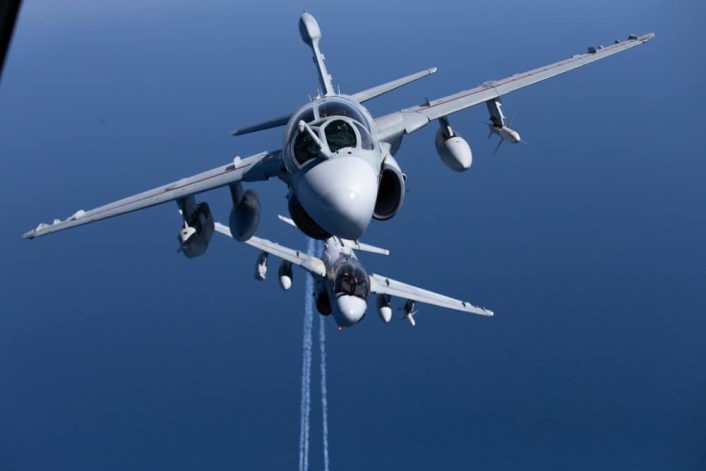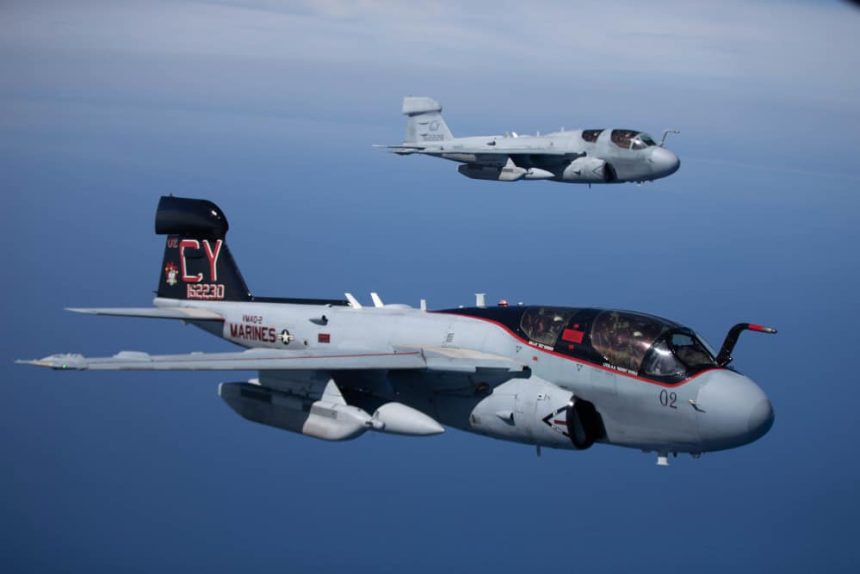Another iconic aircraft is being retired.
The U.S. Marine Corps is deactivating its last remaining EA-6B Prowler squadron on Mar. 8, 2019.
Marine Tactical Electronic Warfare Squadron 2 (VMAQ-2) was the last to fly the Prowler in combat, supporting troops who were taking on Islamic State group terrorists in the Middle East late last year.
The EA-6B was born out of military requirements during the Vietnam War. It entered service in 1971 and 170 aircraft were built before the production was terminated in 1991. For more than four decades, the Prowler has been “at the forefront of military electronic warfare allowing high-profile air combat missions.”
The squadron completed its last deployment in support of Operation Resolute Support and Freedom’s Sentinel in Afghanistan as well as Operation Inherent Resolve in Iraq and Syria in October 2018.
During the last deployment the aircraft have supported ground-attack strikes by disrupting enemy electromagnetic activity and, as a secondary mission, they have flown to collect tactical electronic intelligence within a combat zone. Despite their age, the EA-6Bs have been among the most important assets in the air war against Daesh: they eavesdropped “enemy” radio signals and jammed those frequencies in order to prevent terrorists from talking one another on the radio or cell phone, or use portable transmitters to trigger IEDs (Improvised Explosive Devices).
The main aircraft equipments were the AN/ALQ-99 and USQ-113 pods, whose number and position on the underwing pylons depend on several factors.
The AN/ALQ-99 is used to blind enemy radars, and the ECMO-2 and 3, the back seat flyers, are responsible for it, while the USQ-113 is used to jam the enemy interceptors radio communication in order to prevent them communicating with their GCI (Ground Controlled Interceptor) or with other fighters. This is operated by the ECMO-1 who sits next to the pilot and is responsible also for the radio communication, the navigation and the defensive electronic countermeasures of the aircraft.
These pods use the data library of the computer of the aircraft. Here inside, all the main characteristics of the frequencies and “signatures” of any radar used by the enemy is recorded. The ECMOs analyze the signals received from the on board passive systems and once checked the type of radar that emitted them, start tailoring the jamming required to face it.
The jamming can consist in a saturation of the radar frequencies to blind it completely or in a deceiving with false targets appearing on the enemy radar screens. If the crew decide to destroy the enemy radar, its signal is stored in the on board computer that transmits it to the launch computer of the missile, the Command Launch Computer, that identifies and visualizes the target and set the priority among more than one target.
Once launched, at a distance of less than 30 nautical miles, this jewel 316.856 Dollars worth, heads at 2.280 Km/h against the target, destroying it with the fragmentation of its warhead that embodies a proximity sensor. One of the biggest trouble the Prowler community and planners had to face during Northern and Southern Watch and Allied Force is that some pro-Russian countries (such as Iraq and Yugoslavia) use some old SA-2 and SA-3 systems recently upgraded. The CIA and NSA (National Security Agency) knew little about these systems before those commitments and this means their data weren’t in the archive of the Prowlers’ computers. Despite being based on old fashioned SAM systems, the upgraded SA-2 and 3, use seeking and tracking systems that must be still discovered and analyzed. Thanks to the Prowler some of these system have today less secrets for the NATO than before and represent just limited threats.
EA-6B deployed more than 70 times to support every major combat operation, including those in Libya, Iraq, Afghanistan, Syria and Serbia.
Dealing with the support of operations in the Balkans, here’s what this Author wrote some years ago in a detailed report you can find here. It’s interesting because it draws one of the peculiar mission flown by the Prowler:
Commonly, EA-6B flew missions in pair, orbiting at medium level: old low level flights were banned in the Kosovo theatre of operations since the risk to fly through SAM, MANPADS and AAA range was very height below 15.000 feet.
The orbit was positioned at a variable distance from the target depending on the weather conditions and altitude in the area, and reciprocal position and separation of the two aircraft was maintained referring to a previously established point, code named “Bullseye”, whose distance and radial were broadcasted in frequency by the pilot of the leader aircraft to the wingman using one of the on board radios (2 UHF, 2VHF, 1 HF and 1 SATCOM for satellite communications) that use the HAVE QUICK II system. This secure system uses the frequency hopping techniques to fragment the same sentence randomly on more frequencies. However it couldn’t be used in all missions because packages in Kosovo were also composed by aircraft belonging to nations not equipped with HQ radios compatible with the US ones. This usually compelled all aircraft to broadcast their messages “in the red” (in the clear) with heightened risk of being heard by the enemy, even though the codewords were changed daily and most of the mission was flown “COM out”.
The pre-planned orbits were performed with the help of the INS and GPS: aircraft flew in such a way that while the first aircraft was in the turn or in its outbound lag from the target position, the other was flying inbound to the objective, in order to continuously blind the enemy radars even if one of the emitters’ effectiveness is reduced by the fact that an aircraft is turning. Since the Prowler pods emit their electronic jamming parallel to the longitudinal axis of the aircraft, orbits were always perpendicular to the target.
Being some of the most valuable targets for the enemy anti-aircraft defenses that used upgraded SA-2, SA-3, and modern SA-6, the Prowlers, when orbiting shared all the signals received via data-link. The aircraft of the flight usually jammed the enemy radars alternately to deceive the last generation missiles that autonomously head towards the source of the “jamming”: this tactics was aimed to confusing SAMs by way of continuous variations of the position and intensity of the signal emitted by the source aircraft.
Three Prowler squadrons were deactivated ahead of VMAQ-2. VMAQ-1, in May 2016, VMAQ-4 in June 2017 and VMAQ-3 in May 2018.










